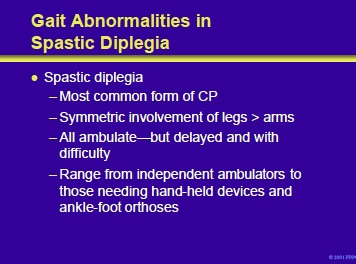Page 21 of 26

Spastic diplegia is the most common form of cerebral palsy. It presents with symmetric involvement of the legs and arms. All patients eventually ambulate, but walking is delayed and difficult. The degree of difficulties with gait in patients with spastic diplegia range from independent ambulators to those patients requiring hand-held devices and ankle-foot orthoses.
Temporal-spatial and EMG features of spastic diplegia are beyond the scope of this slide kit.
However, useful kinematic features of the gait in a patient with the classic form of spastic diplegia include:
- Forefoot strike with early heel rise
- Increased knee flexion
- Adduction and internal rotation of the hip
- Stiff-knee gait
- Excessive lumbar lordosis
- Increased hip flexion
Add comment